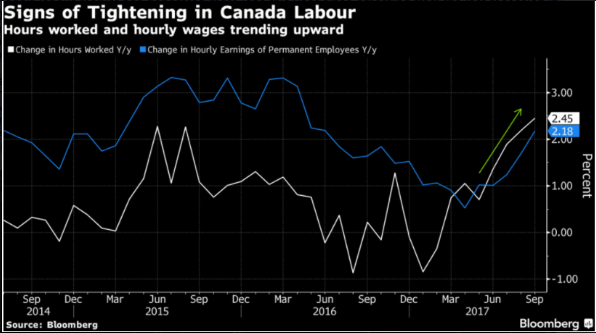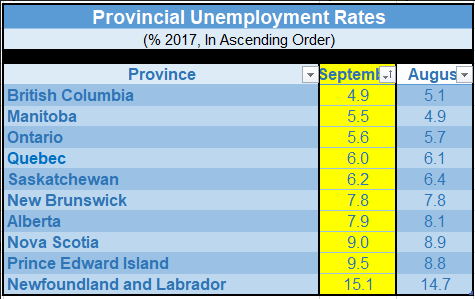the right broker for you.
Contact Us
We will get back to you as soon as possible
Please try again later
Contact Us
We will get back to you as soon as possible
Please try again later
Wages Growth Accelerates as Canada Adds Jobs For the 10th Straight Month
While the headline net jobs gain was a disappointing 10,000–well below the average monthly increase in the past year–the underlying data in this morning’s StatsCanada release were quite robust.
The jobless rate remained unchanged at 6.2% as the acceleration in wage gains suggests that the economy is close to full employment. Average hourly pay gains hit 2.2% year-over-year, the fastest pace since April 2016, mostly reflecting a long-awaited acceleration in wages in the past few months. The Bank of Canada has cited sluggish wage growth as evidence of slack in the economy. In a reversal of the pattern in August, the rise in full-time jobs was dominant, up 112,000 offsetting a loss of 102,000 part-time jobs.
Canada’s labour market has generated more jobs this year since emerging from the last recession in 2009. Employment growth and rising incomes are fuelling a consumption binge that has made the country’s economy the fasted in the G7. That growth, however, is slated to slow in the current quarter as exports have declined for three consecutive months and housing activity has moved off its peak, especially in the Greater Golden Horseshoe around Toronto.
Faster wage growth, which should eventually feed through to higher prices, supports the Bank of Canada’s view that inflation will return to its 2% target over the next year. After a more dovish speech by Governor Poloz last week trimmed the odds of another rate hike this year, today’s report has led some commentators to suggest another increase before yearend is likely. Much will depend on the pace of overall economic activity, which is slowing. Today’s jobs report is consistent with our view that growth is tailing off to the 2.0%-to-2.5% range, well below the booming 4.5% pace posted in Q2.
The unemployment rate at 6.2% is the lowest in decades except for the period just before the financial crisis in 2008-09 when the economy was running full out.
According to StatsCanada, Ontario was the only province with a notable employment gain for the second consecutive month. There were employment declines in Manitoba and Prince Edward Island. Most of the job gains were in the public sector where educational services led the way, offsetting the losses in August. As well, more people worked in wholesale and retail trade in September, while employment fell in information, culture and recreation. Construction jobs were flat, and real estate related jobs edged down a bit.
Some Other Details In The Canadian Report
- Hours worked are up 2.4% from a year earlier, the most significant annual increase since June 2012
- Total employment is up by about 320,000 over the past 12 months, driven by 289,000 new full-time jobs
- Youth unemployment fell to 10.3%, the lowest on record, as their participation rate dropped. That reflected an increase in the full-time school attendance rate to the highest since 2011
This post was written by Dr. Sherry Cooper, Chief Economist, Dominion Lending Centres. It was originally published here.


QUICK LINKS
HEAD OFFICE

Copyright © 2023 DLC Canadian Mortgage Experts. All Rights Reserved | Privacy & Content Policy



